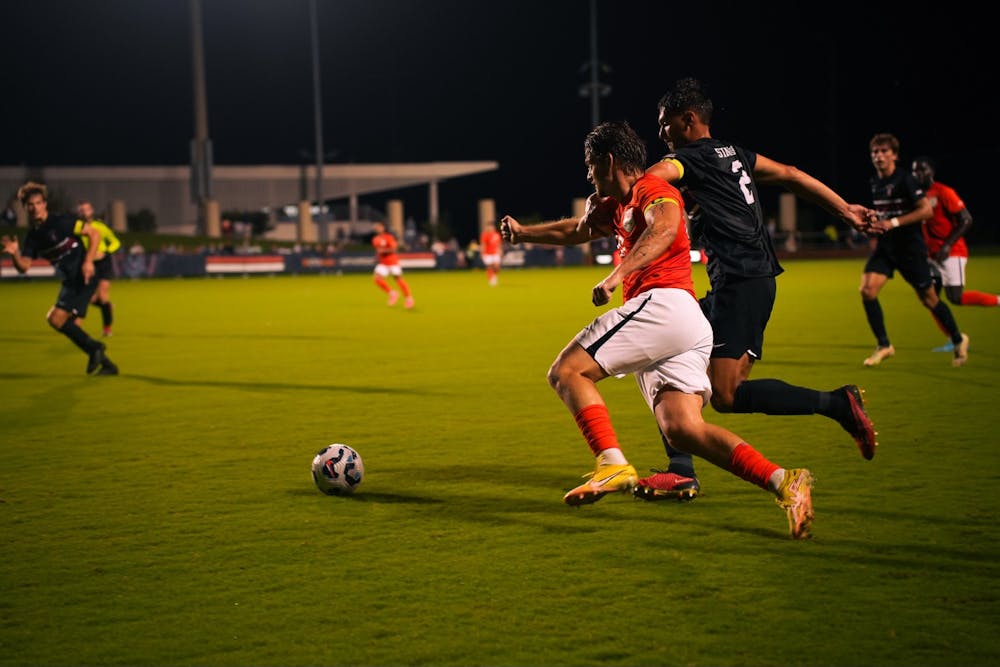It started with one goal. An isolated burst of fortune midway through a season bereft of any.
The free kick deflected off the wall of defenders and into the net, providing the opening goal in Virginia’s 2-1 home victory Oct. 4 against No. 19 Virginia Tech. The win ended a period of 36 days and six games without a win, a near-record dry spell for the program. The Cavaliers went the next 21 days and five games without a loss — or even a draw.
Virginia ended up winning eight of its last 10 games, sprinting through the rest of the season. Even after falling to Wake Forest in the ACC Tournament semifinals Nov. 14, the Cavaliers claimed the No. 11 overall seed in the NCAA Tournament. Coach George Gelnovatch’s team, with a first-round bye, will host a second-round match Sunday at Klöckner Stadium against the winner of Thursday’s game between West Virginia and North Florida.
Virginia’s NCAA Tournament run could stretch for almost another month, taking the team well into December. Or it could end Sunday.
The bracket, released Monday, somewhat shafted the Cavaliers. The first hurdle, Sunday at 5 p.m., will stand a little taller if the opponent is the Mountaineers, as expected.
West Virginia, the first-round game’s hosts, ranked No. 10 in the latest national poll. It defeated No. 8 Marshall, the NCAA Tournament’s No. 13 seed, to win the Sun Belt Tournament on penalty kicks. It has lost only once all season, this perennial soccer power that can reasonably shout about getting snubbed for a top-16 seed.
Last week’s ACC Tournament for No. 9 seed Virginia marked a promising prelude — at the beginning. The Cavaliers took down No. 8 seed NC State in the first round thanks to two second-half goals that arrived 20 seconds apart. Then they barricaded the back line against No. 1 seed Pittsburgh in the quarterfinals, bursting forward to score twice in 25 seconds.
No. 5 seed Wake Forest, however, injected Virginia with a taste of its own medicine. It dumped in three goals in an 11-minute span on its way to a 5-1 win. Virginia deployed the same defensive formation it did against Pittsburgh, except this time with disastrous consequences. Wake Forest Coach Bobby Muus described the formation as a “4-1-4-1, dropping off a little bit, pseudo pressure, but staying organized.”
“I thought [Virginia’s formation] allowed teams that played good football to find a rhythm,” Muus said. “And I thought we were able to find a rhythm early.”
Virginia recovered from a blowout loss once before, shedding the memory of a 4-1 drubbing at Pittsburgh’s hands. It will now attempt to do so again Sunday.
That begins with remaining healthy, which has been an issue this season. In September, Virginia lost junior defender Reese Miller for the season due to an ACL tear. More recently, injuries to sophomore forward AJ Smith, freshman forward Joaquín Brizuela and senior goalkeeper Joey Batrouni have plagued the team.
There is hope, though, as the NCAA Tournament approaches. Smith returned from a month-long absence to score against Pittsburgh. Batrouni entered the Wake Forest game at halftime, after missing the previous game and a half.
He pulled off one ridiculous save, blindly hurling himself to the back post to deny what seemed a tap-in goal. The amazing play, though, got lost in the blowout.
While Batrouni should be healthy for Sunday, the status of Brizuela remains uncertain. The freshman scored four goals in three games to close the regular season but missed the Wake Forest game. Getting him back would be huge for a team that has struggled to identify a reliable option from its revolving cast of forwards.
The Cavaliers’ attack has been inconsistent in 2024, but they have usually been able to trust their defense and midfield. Junior defender Nick Dang and senior defender Paul Wiese landed on the ACC All-Tournament team, while sophomore midfielder Brendan Lambe remains an emblem of consistency.
Virginia will need it all to shove past likely second-round opponent West Virginia in the NCAA Tournament. That could set up a voyage to No. 6 seed Penn, which has lost just one game at home all season. Potential quarterfinal opponents include No. 3 seed Denver and No. 14 seed Indiana.
But Virginia is accustomed to the unremitting struggle of competing against top programs. After all, it plays in the ACC.
“It is [the best conference],” Muus said after the semifinal. “There’s not a day off, right? There’s not a day off at all, and especially now with the three new teams that came in.”
The conference claims nine of the tournament’s teams, seven of the 16 seeded teams. Only five programs have notched a top-16 seed in each of the past three tournaments. All five reside in the ACC.
But only one program has earned multiple top-eight seeds in that time. That is Virginia, and it hopes, this time around, to finally turn its high seeding into a deep run.
The Cavaliers have won just one tournament game in the last two years, tumbling out in the third round last season as the No. 7 seed and in the second round the year before as the No. 4 seed. Getting past the first few rounds would deposit Virginia in the College Cup for the first time since 2019 as it seeks its first national title since 2014.
Virginia has eyed a return to that stage for months. Gelnovatch acknowledged as much in a preseason interview.
“It’s time,” he said then, “to get over the hump.”







